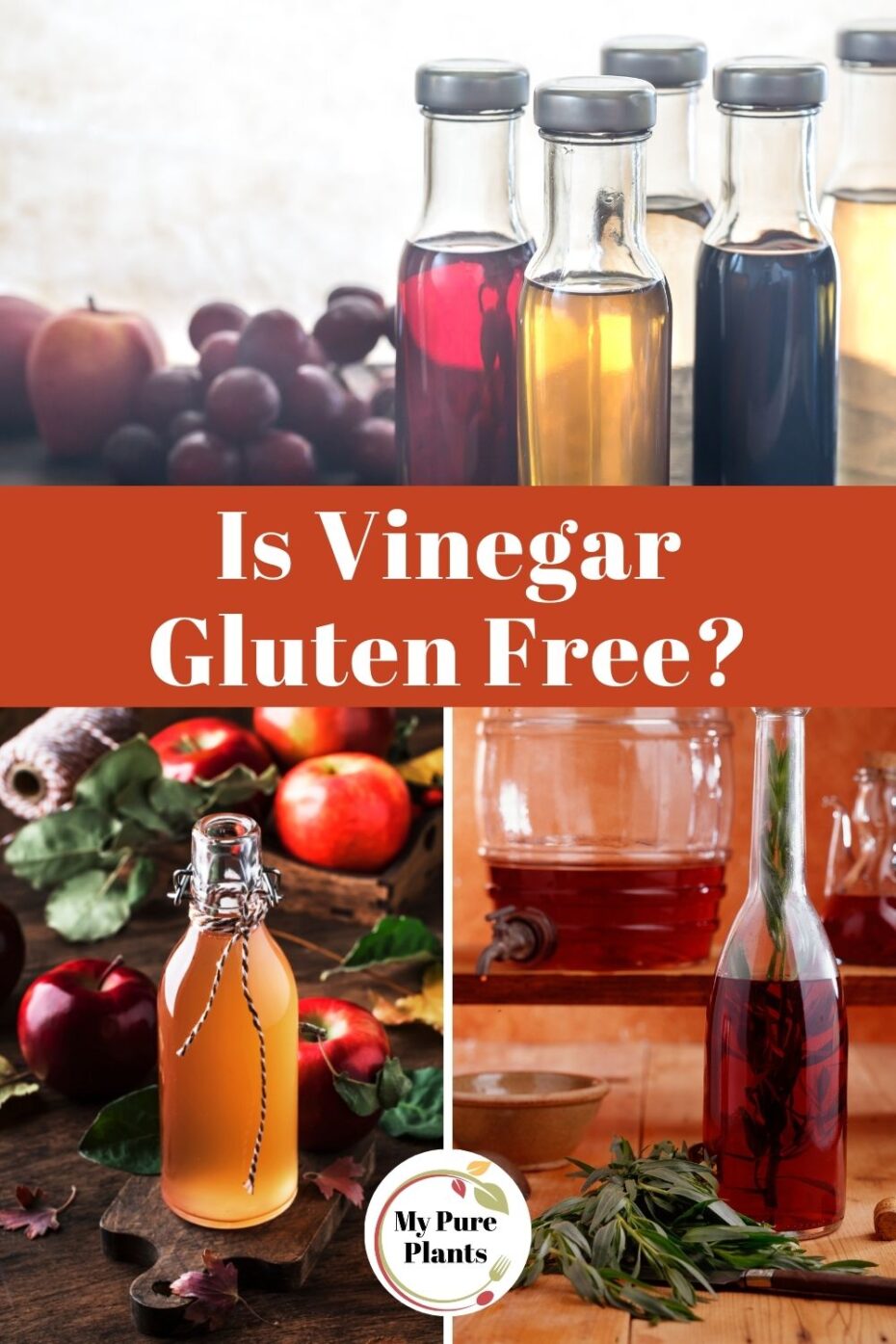Since there are approximately 20 different types of vinegar, answering the question “Is vinegar gluten-free?” might not be straightforward. In this article, we go through several types (balsamic vinegar, apple cider vinegar, rice vinegar, wine vinegar, etc.) to see what are they made of, and which ones are certified gluten-free vinegar brands.

Want to save this post?
Enter your email below and get it sent straight to your inbox. Plus, I’ll send you budget recipes and money-saving tips every week!
What is vinegar?
As grapes are to wine, so is the wine to vinegar. The origin story of vinegar happens to be one of a happy accident. It was when a cask of wine left forgotten sometime around 3000 B.C turned into a magical new ingredient, that the “sour wine” was made. In French, vin means “wine” and aigre means “sour.”
This versatile cooking ingredient stashed in your pantry is undoubtedly an essential part of almost every kitchen in the world today. It is, in essence, a sour-tasting liquid made by fermenting any sugar-containing source to produce acetic acid.
After all these years, the principle of vinegar remains untouched. Following a process of double-fermentation, it has two main steps.
- In the first step, sugar is broken down by yeast anaerobically (without oxygen), to give carbon dioxide and alcohol.
- The second step involves adding oxygen for the bacteria to process. In industries, this is accelerated by supplying oxygen.
Vinegar can actually be made from many sources like fruits (dates, berries, apples, or grapes), alcohol (distilled white vinegar or beer), honey, and cereals (rice, malted barley, or oats). The FDA states that any product called “vinegar” must contain at least 4% acidity.
Different types of vinegar
Across the globe, there are over 20 types of vinegar marketed and many more made at home! Some common kinds of vinegar include
- white vinegar
- balsamic vinegar
- apple cider vinegar
- wine vinegar
- malt vinegar
- specialty vinegars like rice vinegar, coconut vinegar, or raspberry vinegar
- herbal vinegars
Since the purpose of this article is to talk about whether they are gluten-free or not, if you need detailed information on what is exactly in which vinegar, how it’s made, and what to use them for, read this article titled Ultimate Guide to Vinegar.
Difference between distilled and non-distilled vinegars
Distilling vinegar is the process of separating the liquid portion of vinegar from its base mixture by heating it in a boiler and collecting the cooled vapor.
While distilled vinegar can be made from any type of vinegar, non-distilled vinegar or spirit vinegar is usually prepared from sugar cane extract. Corn is what is most commonly used in the US.
The main difference between distilled and non-distilled vinegar is how much acetic acid they contain. While virgin or distilled vinegar has 5-8% acetic acid, white or non-distilled vinegar is much stronger with acetic acid levels ranging from 5-20%. So while you may clean and disinfect with non-distilled vinegar, it’s distilled vinegar you cook with. Read this article, if you want to learn more about how vinegar is made.
Is vinegar gluten-free?
In general, distilled vinegar, red wine vinegar, balsamic vinegar, cane vinegar, and apple cider vinegar are usually safe. Flavored vinegar, on the other hand, as well as certain Asian rice vinegar, and of course malt vinegar (rye, barley), are the ones you need to avoid.
While some experts believe that vinegar that undergoes the distillation process is safe for consumption as gluten is fragmented and eliminated, others consider the current testing methods to be unreliable in identifying smaller particles of gluten. While this is a debated topic in the gluten-free community, the fact remains that vinegar may still pose a potential health risk to celiacs and gluten-sensitive individuals.
The Gluten Intolerance Group (GiG) states on its website that while vinegar used for cooking is mostly distilled and made from gluten-free ingredients, unfortunately, it still cannot be assumed that all kinds of vinegar are gluten-free. Remember that if you react to distilled alcohol made from gluten grains, then there is a high chance that distilled white vinegar isn’t safe for you either.
There is also the issue of manufacturers not being required to disclose the presence of wheat used in the process of making distilled vinegar because it is believed that distillation removes all allergenic proteins.
When you are buying vinegar or vinegar-containing products, check for labels like “no gluten,” “free of gluten,” “without gluten,” and “gluten-free.” Also, keep an eye out for the gluten-free certification mark by the Gluten-Free Certification Organisation (GFCO). If you are extremely sensitive to trace gluten, consider calling the manufacturer before consuming vinegar due to all the above-mentioned reasons.
Here are some gluten-free white vinegar to try:
Modernist Pantry’s White Vinegar Powder
Modernist Pantry’s White Vinegar Powder* is labeled gluten-free and vegan, and can easily be reconstituted and added into your cooking. Containing white vinegar, maltodextrin, and modified food starch, adding this flavoring agent to your marinades for a bit of zing will cause you no harm.
De La Rosa’s Distilled White Vinegar
Imported from Spain and made from organic sugar beets, this organic vegan vinegar sold in a glass bottle is labeled gluten-free. So dress your salads with this De La Rosa’s vinegar* at the next picnic without any worries.
Is balsamic vinegar gluten-free?
It’s a must that balsamic vinegar be prepared either partly or fully from fresh grape juice. Usually made from the Trebbiano and Lambrusco varieties, the entire fruit, including the stem and skin, is placed into a wooden casket. The vinegar is then aged to a dark concentrate with a tart and nutty flavor.
The traditional method of preparation involves aging the vinegar for a minimum of 12 years. It’s then no wonder why this truly balsamic vinegar has a complex taste and is even sipped alone as a palate cleanser! This type is made with a 100% concentration of grape must and contains no additives, rendering it gluten-free. However, it is also true that traditional balsamic vinegar is quite expensive and difficult to come by.
Commercially-made balsamic vinegar of Modena, on the other hand, needs only to be aged for two months, is much lighter in taste, and is mostly only used as a glaze. Containing only a small percentage of must (as little as 20%), this vinegar is inexpensive and easily found in local supermarkets. However, it should be noted that the lower the quality of balsamic vinegar, the higher the number of additives, increasing the risk of one of them containing gluten.
Furthermore, as balsamic vinegar is made from grapes and aged in wooden caskets, there is a tiny risk of contamination from the wheat-based paste that is sometimes used to seal the casks. While the chances of this are pretty low, it’s best to just play it safe and opt for the certified gluten-free varieties of vinegar. Here are some to try out:
Giusto Sapore
This vinegar has no gluten, is completely organic, and is also P.G.I. certified. Giusto Sapore Balsamic Vinegar* is a family-made product of Italy, and contains wine vinegar and grape must. This unpasteurized vinegar is a healthy and delicious garnish for your meals. For maximum health benefits, add in a bit of the “mother,” a spiderweb-like clump found at the bottom of the bottle, too.
Monari Federzoni
Coming straight from Italy, Monari Federzoni Glaze* is surely inspired by the Modena way. It is made from 35% balsamic vinegar of Modena, which is made from wine vinegar and must; concentrated grape juice; modified corn starch, and caramel coloring. This creamy sweet vinegar is gluten-free and makes for the perfect dipping sauce.
Is malt vinegar gluten-free?
While the distillation process usually leaves vinegar containing gluten well below the 20 ppm as recommended by the FDA, the simple and unfortunate fact of the matter is that malt vinegar is not distilled.
Final consensus, you ask? Being derived from the gluten-containing grain barley, malt vinegar is not gluten-free. It’s best to just skip this one altogether and try another variety of vinegar instead.
Is apple cider vinegar gluten-free?
This kind of vinegar is produced by the fermentation of crushed apples and therefore contains both acetic and citric acid. Since the US has no absolute definition for the recipe of apple cider vinegar, its composition varies across various different products found in the market.
While apple cider vinegar should not contain any gluten, always look at the label for added flavorings that might contain gluten. It is especially important in gluten-free baking. It is usually added to baked goods like chocolate cake to react with baking soda and level the batter.
Here are a few that are sure to fit your gluten-free needs:
Braggs
Braggs’ Apple Cider Vinegar* is one of the most well-known and widely available brands in the US. You have a good chance at bumping into one in your local supermarket. This vinegar is USDA certified organic, unfiltered, unpasteurized, and naturally gluten-free.
Dynamic Health
Spice up your breakfast smoothie with a dash of this pure, raw unpasteurized vinegar. Diluted to 5% acidity, Dynamic Health Organic Raw Apple Cider Vinegar* not only has zero gluten, but is also vegan, and non-GMO as well. Try mixing it with just a little honey, tea, or maple, and sip your favorite healthy beverage every morning.
MB Herbals
Labeled “gluten-free,” this spray-dried apple cider vinegar powder is perfect for dissolving in water and consuming directly, or for adding in soups and sauces for that extra punch. Prepared from apples grown on the foothills of the Himalayas, MB Herbals’ Apple Cider Vinegar Powder’s* main ingredients are maltodextrin and apple cider vinegar.
Is rice vinegar gluten-free?
This pale yellow vinegar is made by fermenting rice wine. Its 4 to 5% acidity gives it its characteristic mild sweet taste, which is so common in Chinese and Japanese cuisine. The types include white rice vinegar, red rice vinegar, black rice vinegar, and seasoned rice vinegar.
While rice vinegar inherently has no gluten, the added grains to the vinegar might be problematic. Some Asian labels might not specify if they are gluten-free, so carefully read through the ingredient list before you buy any. Rice vinegar is a popular ingredient in sushi rice so take caution when ordering sushi. You can find more info in our “Is sushi gluten-free?” article.
Marukan
Marukan Rice Vinegar* is sugar-free, sodium-free, gluten-free and it makes a fantastic accompaniment to sushi. You can even try adding it to pickles or marinades (like we did in our Vegan Orange Chicken recipe) to achieve that authentic Asian sweet-umami flavor profile.
Kikkoman (not gluten-free?)
Kikkoman rice vinegar* is another popular brand but on their website, it is not listed in the GF products section. Based on ingredients it should be gluten-free, maybe it is just not certified. In any case, please be aware of this info when choosing rice vinegar for you.
Is wine vinegar gluten-free?
As the name suggests, wine vinegar is derived from wine. Milder and less acidic than their contemporaries, both red wine vinegar and white vinegar are what bring life to salads and sauces. Being a staple of Mediterranean cooking, a sprinkling of wine vinegar is also often used to amp up pasta dishes. We also use it to make Chimichurri Sauce, Coleslaw Dressing, Tzatziki, or Sofritas.
While wine vinegar is essentially gluten-free, it always does well to read through the ingredients to make sure there are no added gluten-containing substances.
Dr. Mercola’s Solspring
This premium white wine vinegar is made from Roditis and Savatiano grapes cultivated on a biodynamic site in Greece. Completely gluten-free, Dr. Mercola Solspring Biodynamic Organic White Wine Vinegar* has a crisp flavor and is known to leave a pleasant aftertaste on the tongue.
Liokareas
From the Peloponnese and Messinian Valley of Greece, Liokareas Red Wine Vinegar* bears the gluten-free label. The family-run brand guarantees an exquisite tasting experience that pairs well with most dishes, but especially best with heartier flavors like beef, pork, and vegetables. It’s the kind of vinegar that is bound to become your salad’s best friend.




Leave a comment